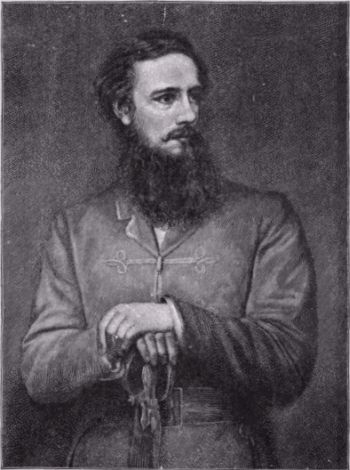(1822-1857)
Brigadier General John Nichols on was a dynamic, charismatic, and indefatigable Bengal Army leader, worshiped by some locals as a god named Nikalsain. He distinguished himself during the Indian Mutiny and was killed leading the attack on Delhi.
Nicholson was born in Ireland in December 1822 and was educated at Dungannon College. He received a Bengal Army cadet ship in 1839 and served in the First Afghan War. Nicholson participated in the defense of Ghazni and was taken prisoner when the garrison surrendered on 1 March 1842, although he escaped by bribing a guard. He was later appointed political officer in various regions and was assigned to the British force during the Second Sikh War. After this conflict, Nicholson became deputy commissioner of the Bannu district, where he earned a reputation as a strict but fair disciplinarian. He reportedly personally pursued criminals and displayed their severed heads on his desk.
When the Indian Mutiny broke out in May 1857, Nicholson was deputy commissioner of Peshawar. Actions were taken immediately to dis arm suspect native regiments, secure arsenals, and safeguard key positions. Nichols on was given command of the Punjab Moveable Column and advanced toward Delhi, disarming wavering sepoys and hanging mutineers en route.
Nicholson’s column reinforced British forces, commanded by Brigadier General Archdale Wilson, on the Delhi Ridge on 14 August 1857. On 7 September 1857, the British began preparations for besieging Delhi, which they eventually stormed. The attack on Delhi, with Nichols on leading the main column and designated the overall assault force commander, began early on 14 September. The Kashmir Gate was captured, but a number of attempts to seize the Lahore Gate were unsuccessful. Nicholson then waved his sword above his head and faced his soldiers to exhort them to follow him. As he did so, his back was momentarily presented to the rebels, who shot him. His wound was fatal, although he lingered until 23 September.
References: Edwardes (1963); Hibbert (1978); Hilton (1957); Leasor (1956); Waller (1990)
Delhi
Gurkhas and British Army units, as well as the Punjab Moveable Column commanded by the inspiring Brigadier General John Nicholson, arrived in Delhi by 14 August 1857 and increased the size of the Delhi Field Force by 4,200 men. The slow-moving British siege train reached Delhi on 4 September 1857, and the siting of the artillery began on 7 September. The following day, the British artillery barrage began, and the intense fire breached the Delhi city walls in a number of locations. The British force, divided into five columns, attacked Delhi early on 14 September. The first three columns (1st Column: 75th Foot, 1st Bengal Fusiliers, and 2nd Punjab Infantry, totaling 1,000 men; 2nd Column, consisting of 8th Foot, 2nd Bengal Fusiliers, and 4th Sikhs, 850 men total; and 3rd Column: 52nd Foot, Kumaon Regiment, and 1st Punjab Infantry, totaling 950 soldiers) were under Nicholson’s overall command, and their mission was to seize the Water Bastion and then the Kashmir Gate. The 4th Column (Sirmur Battalion, Guides’ Infantry, and a composite force of pickets, totaling 850 men, with 1,000 soldiers of the Kashmir Contingent in reserve), commanded by Major Charles Reid, was to cover the right flank of Nicholson’s force and capture the suburb of Kishangunj. Brigadier General Longfield’s 1,000-man 5th Column (61st Foot, 4th Punjab Infantry, and the Baluch Battalion) remained in reserve.
The British assault began on 14 September 1857 under a hail of rebel musketry fire and grapeshot, and a foothold was gained in the city after severe British losses, including the charismatic Nicholson. The Kashmir Gate was blown by sappers and created a significant breach in the walls. Confusion, poor coordination, and hard fighting followed. By the evening of 14 September, the British had established a foothold in the city, but at a cost of 66 officers and 1,104 men killed and wounded. After six days of determined (and occasionally drunken) urban fighting with no quarter given on either side, the British captured Delhi, suffering a tot al of 1,574 officers and men killed and wounded during the operation. The advance, according to many junior officers, was characterized by “the utmost incompetence” (Hibbert 1978, p. 310).The British victory was followed by looting, revenge, and the execution of mutineers.
Bahadur Shah was captured and his sons were shot after they surrendered to the British. The fall of Delhi was the turning point of the Indian Mutiny and ended mutineer dreams of a revived Mughal Empire. Moreover, it freed British troops to fight at Cawnpore and other locations.
References: Edwardes (1963); Collier (1964); Hibbert (1978); Hilton (1957); Leasor (1956)
